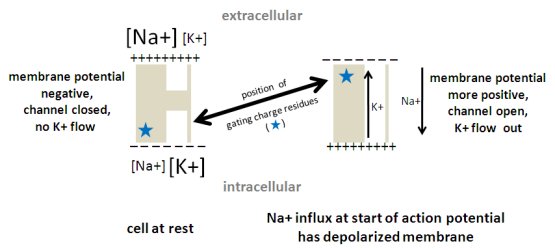

| Figure 1. Gating charge residue position gates the K+ channel in response to changing membrane potential. In a resting cell (left), the membrane potential is negative (inside of cell is negative relative to outside). The positively charged gating charge residues lie closer to the intracellular side of the channel, and the channel is closed. After Na+ begins entering the cell at the begining of an action potential (right), the membrane is depolarized, the gating charge residues shift towards the extracellular side of the channel, and the channel opens, allowing K+ to flow out of the cell down its concentration gradient. As the resting membrane potential is thus restored, the gating charge residues shift back towards the intracellular side of the channel, and the channel closes. |